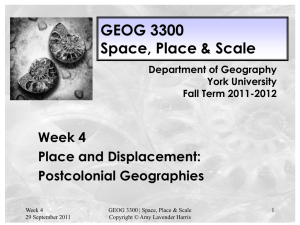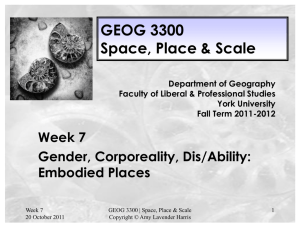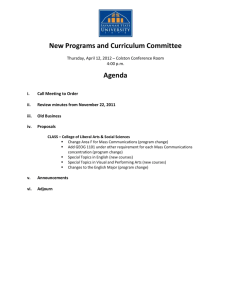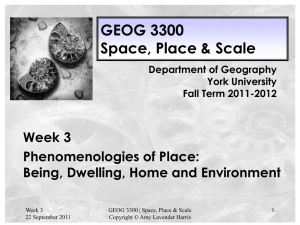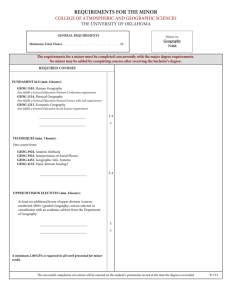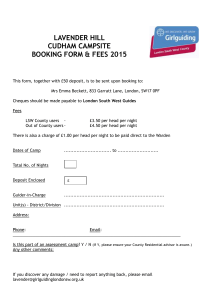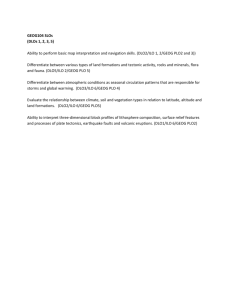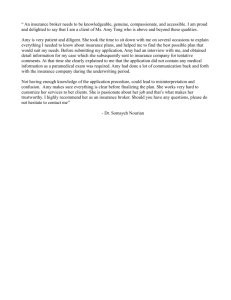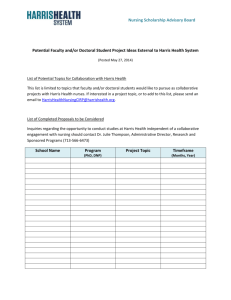GEOG 3300 Week 9 lecture slides 2011
advertisement
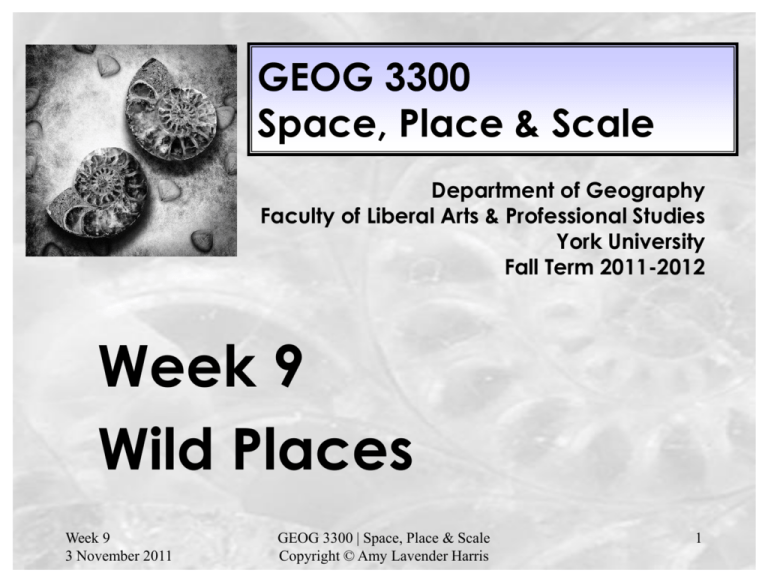
GEOG 3300 Space, Place & Scale Department of Geography Faculty of Liberal Arts & Professional Studies York University Fall Term 2011-2012 Week 9 Wild Places Week 9 3 November 2011 GEOG 3300 | Space, Place & Scale Copyright © Amy Lavender Harris 1 Wild Places • When we talk about wild places, we are also having a discussion about nature and culture and the places they intersect. • We tend to think and speak of ‘natural’ or wild places as if they must remain separate from cultural or cultivated spaces: as if they are binary opposites. • Wild places elicit contradictory sentiments: reverence and terror; fear and wonder. Why? [19th century Romanticism] • In Landscape and Memory (1995), Simon Schama calls this sentiment “ delightful horror”. Tellingly, Schama begins a chapter with this comment: “It was when his lapdog, Tory, got eaten by a wolf that Horace Walpole began to have serious reservations about Mont Cenis.” (447) Week 9 3 November 2011 GEOG 3300 | Space, Place & Scale Copyright © Amy Lavender Harris 2 Nature and Culture • ‘Nature’ refers not only to natural objects (trees, rocks, flora and fauna) but also to the concept of nature and its origins and implications. (Neil Evernden, The Social Construction of Nature) • ‘Nature’ enfolds a paradox: the rational (‘laws of nature’) paired with the savage (‘natural laws’; e.g., the nature that the poet Tennyson described as “red in tooth and claw”) • In western thought, ‘nature’ is consistently measured against its opposite: the cultivated, or culture. • An interesting paradox occurs when we call something “wild” • Wild must be measured against something: something cultivated, tame, rational, human. Nature is the West’s ultimate ‘Other.’ • This brings us back to the old ‘culture-nature’ duality we’ve encountered before. Week 9 3 November 2011 GEOG 3300 | Space, Place & Scale Copyright © Amy Lavender Harris 3 ‘Purifying’ Ontological Categories • In the playful ‘anthropology of science’ We Have Never Been Modern, philosopher Bruno Latour suggests that we ‘purify’ ontological categories (such as nature and culture) by eliminating objects that call their separation into question. • Examples? Spatial implications? • Our fetish with hygiene and germ-killing; our discomfort with wild animals (e.g., feral cats) in urban spaces; social unease about homelessness; disgust at scavenging or “dumpster diving;” concealment of waste; taboos against public expressions of (visceral, animal) sexuality – unless it is ‘sterilized’ Week 9 3 November 2011 GEOG 3300 | Space, Place & Scale Copyright © Amy Lavender Harris 4 Breaching Ontological Categories: Feral Cats, Homelessness, Bottle Picking and Dumpster-Diving • In ‘Feral Cats and the City’ (2000), Griffiths et al argue that westerners’ attitudes toward animals involve a “dialectic of desire and disgust.” • This dialectic is informed, among other things, by ‘domesticity.’ (pets: neutered, regulated, ‘inside’) • Feral cats call this dialectic into question, because they “occupy a zone somewhere else on the domestic-wild spectrum,” “transgress the boundary between civilization and nature” and occupy an “interstitial space.” • Cockroaches, rats, bedbugs? Eyebrow mites? Spiders? [Charlotte’s Web] Week 9 3 November 2011 GEOG 3300 | Space, Place & Scale Copyright © Amy Lavender Harris 5 Transgressing the ‘Purity’ of Urban (or rural) Places • Urban environments as ordered, contained: what belongs or do not belong. • Ambivalence about nature means these categories are in flux: anything that transgresses any given order (feral cats, homeless people, rats, cockroaches) creates tension and breaches the inherent brittleness of out dualities. • Cloke et al (2000) argue that a similar ‘ordering’ occurs in rural places. Homelessness (for example) is ontologically separated from discourses on rurality. • Cloke et al argue that our definitions of homelessness require revision. [City of Toronto defines homelessness quite broadly] • ‘Rural’ forms of homelessness in cities? Colonies in the Don Valley? Week 9 3 November 2011 GEOG 3300 | Space, Place & Scale Copyright © Amy Lavender Harris 6 ‘Unpurifiying’ Our Ontologies: Living with Nature • Peters (1979; discussed in Griffiths et al) suggests we “make room for” weeds – what else might we accommodate? • Acknowledge that ontological categories cannot be ‘purified’ • How we deal with waste; difference; anything undomesticated Week 9 3 November 2011 GEOG 3300 | Space, Place & Scale Copyright © Amy Lavender Harris 7 Transforming Nature into Culture: the Caged Tree • Artist Tony Urquhart’s tree sequence discussed by Gary Michael Dault in Cells of Ourselves (Porcupine’s Quill, 1989) illustrates one expression of ambivalence about nature, and the lengths we go to in our efforts to transform it into culture and in doing so, to conceal its ‘wild’ origin. • How do these transformations affect the places in which they occur? Week 9 3 November 2011 GEOG 3300 | Space, Place & Scale Copyright © Amy Lavender Harris 8 The tree, caged as a sapling, is not a “pure gift” anymore; it is boxed, imprisoned, captured by our gaze. What kind of place is this? Week 9 3 November 2011 GEOG 3300 | Space, Place & Scale Copyright © Amy Lavender Harris 9 As it grows, the tree breaches its enclosure but remains imprisoned by it. Week 9 3 November 2011 GEOG 3300 | Space, Place & Scale Copyright © Amy Lavender Harris 10 As some point the tree is sacrificed to its enclosure. At what point does it become a ‘machine for living’? Week 9 3 November 2011 GEOG 3300 | Space, Place & Scale Copyright © Amy Lavender Harris 11 Going Wild in the Land • In Getting Back Into Place (1993), Edward Casey discusses the uneasy relationship between culture and nature, and suggests that we might find some way of “negotiating the middle realm” through activities like walking and guiding. • Casey’s instruction (following Thoreau and Muir) is simply “to walk out of a domestic and local culture.” (247) – to leave it temporarily or perhaps permanently. • This, he says, gives us a new perspective, opens up new panoramas through which we may re/view culture and the human spaces we occupy and inhabit. • The word “saunter”, Casey suggests, refers originally to being “sans terre”, or being at home nowhere or everywhere. [note subtle nod to psychogeography here] • At this point, we are (perhaps) able to see the earth not just as a space but as the place of all places. Week 9 3 November 2011 GEOG 3300 | Space, Place & Scale Copyright © Amy Lavender Harris 12 Critical Essay (Term Paper) • Reminder that you will write a critical term essay of 10-12 pages, due on 6 December 2011. • Opportunity to write about any theme or issue that interests you, as long as it develops an understanding of some aspect of space/place/scale. • Must be informed by a theoretical approach / contextual literature. • Must be analytical rather than merely descriptive (take an opinion, and/or apply the theoretical concepts to a new experience or setting). • Recommendation: choose a specific subject, theme, place, or experience Week 9 3 November 2011 GEOG 3300 | Space, Place & Scale Copyright © Amy Lavender Harris 13 Outline and Annotated Bibliography • Due 17 November 2011 (note new due date); worth 10% of your final grade. • 1-2 page outline introducing your topic and the main cases examples or arguments you will use to explore it. • Your paper may (and probably will) change after you submit the outline: the purpose of submitting an outline is to receive feedback well before submitting the final paper. • Annotated bibliography: at least five scholarly sources – write 50-100 words about each source, offering a brief overview of the work and indicating its anticipated relevance to your work. Week 9 3 November 2011 GEOG 3300 | Space, Place & Scale Copyright © Amy Lavender Harris 14 GEOG 3300 Term Paper: Suggestions for Organization Section Content Pages 1 Introduction: thesis statement (explain what you are writing about, how you will do so, and why it is important or meaningful), summary of arguments you will use 1 or 2 2 Context / background: brief explanation of theoretical perspective(s) that inform your paper. Where does this perspective ‘fit’ in the literature/debates on SPS? 2 to 3 3 Analysis: A thoughtful, complete exploration of your subject (using evidence and examples) that justifies / fulfills your thesis statement. 5 to 7 4 Conclusion. 1 at most Don’t forget to choose an interesting title and provide full references and notes as necessary. Yes, you can use “I”. Week 9 3 November 2011 GEOG 3300 | Space, Place & Scale Copyright © Amy Lavender Harris 15 Your Topics? Week 9 3 November 2011 GEOG 3300 | Space, Place & Scale Copyright © Amy Lavender Harris 16 Finding Scholarly Articles • Scott Library homepage: http://www.library.yorku.ca • Under eResources, click on “Find articles by subject” • (for example) Geography Research Guide: http://www.library.yorku.ca/ccm/rg/tb/Geog.jsp • Note that there is also a “Toronto Resources” subject guide: http://www.library.yorku.ca/ccm/rg/pt/Toronto.jsp • A shortcut is to use JSTOR (Journal Storage) by typing JSTOR into the “Title Quick Search” box at the top right corner of the Library main page. Alternatively, you can type “Scholars Portal” or “Proquest” into the same box. This will take you directly to these scholarly journal databases / search engines. Week 9 3 November 2011 GEOG 3300 | Space, Place & Scale Copyright © Amy Lavender Harris 17 Other Acceptable Sources • Please note that your paper should be informed by one or more scholarly/critical perspectives. This means you will mainly use scholarly books and articles. • It is also okay to use non-scholarly sources to supplement your scholarly material (e.g., newspapers, if you want to do a content analysis, diaries, journals, memoirs, weblogs, policy documents, statistical data), as long as you interpret them in the context of the scholarly literature. • Wikipedia: is not really a ‘source’ at all. Like a dictionary, it can be a useful place to start your research. Do not use Wikipedia as a reference in your essay. • Personal interviews (if applicable) Week 9 3 November 2011 GEOG 3300 | Space, Place & Scale Copyright © Amy Lavender Harris 18 Further Considerations: • Because your paper will be fairly short (10-12 pages), you will not have room to take on a big subject. • Accordingly, be specific and clear and focused. • Begin your paper with a solid, strong thesis statement. • Have an opinion. • Define your terms and concepts. • Have some fun. • Please don’t hesitate to use the first person (“I”) if it seems appropriate. • Cite your sources properly and include full bibliographic information. Week 9 3 November 2011 GEOG 3300 | Space, Place & Scale Copyright © Amy Lavender Harris 19
